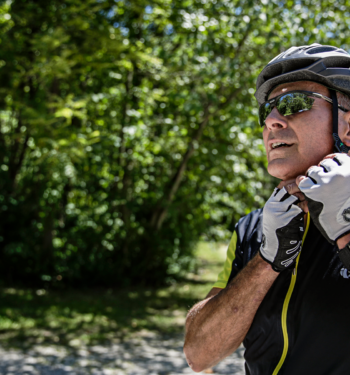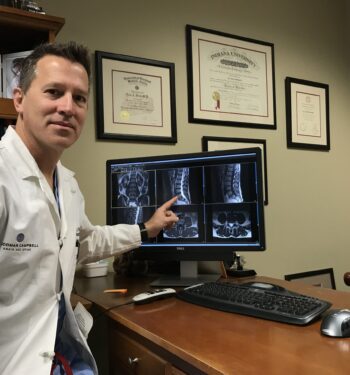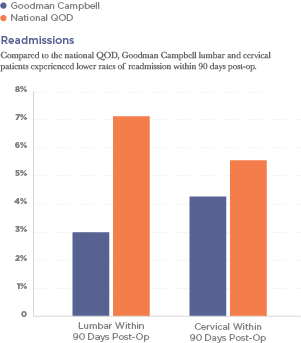December 16, 2016
Handle acute back pain with care, and it won’t keep you down for long.
Almost everyone experiences acute back pain at some point in their life. A trip to the doctor is often an unfortunate result of a spirited soccer match or ambitious afternoon of garage cleaning!
Most sudden attacks of acute back pain are the result of overstretched muscles (strains) or ligaments (sprains). The pain may be most severe immediately after injury, or it may worsen gradually over a few hours. In most instances, back pain as a result of strain or sprain can be resolved following a conservative course of treatment-usually within two to six weeks-provided there are no serious underlying medical conditions. Identifying the cause of the pain, alleviating the pain- either at home or with your physician’s help-and avoiding re-injury are key to the healing process.
What Caused My Acute Back Pain?
Common causes of strains and sprains that can trigger acute back pain include:
- Improper lifting
- Sudden, strenuous physical effort
- Accident, sports injury or fall
- Sleeping position and/or pillow positioning
- Poor sitting or standing posture
- Bending forward too long
- “Hiking” your shoulder to hold the phone receiver to your ear
- Carrying a heavy purse, briefcase or backpack
- Stress and muscle tension
Physical conditions that can possibly contribute to the onset of acute back pain include:
- Lack of muscle tone
- Excess weight
- Pregnancy
What Are My Treatment Options?
Home Or Hospital?
The first step is to assess the severity and cause of your acute back pain to determine whether you need to see a physician. Consult a physician immediately if you:
- Are experiencing numbness in, or having difficulty moving, your extremities
- Experience bladder control loss or impairment
- Develop a fever or severe headache
- Are over 60 and have been taking steroids for a long period of time
- Experience chest pain or pain in the left arm
- Are pregnant
- Do not experience any improvement after 72 hours of self-treatment at home
Home Remedies
If you’re not experiencing any of the above symptoms, there are several things you can do at home to help soothe your sore back:
Bed Rest Isn’t Best. Going about your normal, everyday activities-but perhaps at a slower pace, and definitely avoiding what may have caused your pain in the first place-is a good way to start the healing process. A little “couch time” won’t hurt, but light activity speeds recovery, so avoiding lying down for long periods of time.
Hot And Cold. Heat and cold, in the form of a hot bath or hot and cold compresses, can help relieve sore and inflamed muscles and tissue. Remember-cold comes first! Wrap an ice pack (or a bag of frozen vegetables) in a thin cloth to avoid frostbite, and apply to the affected area for up to 20 minutes several times a day. Ice slows inflammation and swelling, numbs tissue and slows nerve impulses to the injured area.
Once the acute pain and muscle spasms subside (about 48 hours after the first onset of pain is recommended), you can apply heat-to loosen muscle tightness – by taking a warm bath or using a heating pad, heat pack or heat lamp.
Pain Relief In A Pill. Non-steroidal anti-inflammatory drugs, such as aspirin, ibuprofen, acetaminophen or naproxen sodium, can ease pain, swelling and stiffness. There are a number of over-the-counter and prescription options. Your pharmacist can help you determine which is best for you.
Support Yourself. If you must sit or stand for long periods of time, consider using a brace or corset. Worn properly, they can relieve pain and provide warmth, comfort and support. But, don’t rely on this type of external support too long-allowing it to perform your muscles’ job will eventually weaken them, making re-injury easier.
If your back pain hasn’t improved noticeably after 72 hours of self-care, contact your health care provider.
How Can I Prevent Re-Injury?
To prevent re-injury of your back-and hopefully avoid any recurrence of acute back pain-it’s important to build and maintain the strength and flexibility of those muscles, tendons and ligaments that support your back and spine. You can do this through:
Exercise
- Regular, low impact cardiovascular exercises that don’t jar your back and are easy on the joints, such as bicycling, walking or swimming. If exercising outdoors is not option, consider using a treadmill, elliptical trainer or stationary bicycle. These can be found at almost any exercise studio, or you can buy a home version at your local sporting goods store.
- Core strengthening exercises. By conditioning your abdominal and back muscles, you can develop a “natural corset” to support your spine.
- Gentle stretching to improve and maintain flexibility.
A Healthy Lifestyle
- Eat a nutrient-rich, balanced diet, with sufficient intake of calcium, Vitamin D and phosphorus. (Phosphate makes up more than half the mass of bone mineral; Vitamin D helps maintain appropriate calcium/phosphorus levels. When phosphorus is too high, the body takes calcium out of the bones to bind with the phosphorus and remove it from the blood. Bones become brittle as a result.)
- Avoid smoking and excessive alcohol use.
- Maintain a healthy weight- additional pounds place excess strain on spinal vertebrae and discs.
- Stay well-hydrated. The body is 70% water, and sufficient hydration contributes to intervertebral disc health and that of other back related structures and functions.
- Get your vision checked. Poor vision can affect the way you carry yourself, which can contribute to back problems.
When Standing
- Place feet shoulder width apart, don’t lock your knees;
- Avoid arching your lower back or slumping your upper back and shoulders;
- Keep your breastbone up, shoulder blades down;
- Keep your chin level, relax jaw and neck muscles.
When Sitting
- Rest your feet on floor with knees and hips bent 90 degrees;
- Maintain a neutral arch in your lower back;
- Keep your breastbone up, shoulder blades down;
- Keep your chin level, relax jaw and neck muscles.
When Driving
- Adjust your seat so that the back is vertical. Your back should be supported by the seat back and your head should rest against headrest with your chin level;
- Knees should be bent, and at least at the same height as your hips;
- Elbows should be slightly bent and relaxed, with your shoulders down.
When Sleeping
- Use a firm mattress. Placing a board between the mattress and box spring can provide a temporary fix for one that is sagging.
- Lie on your back or side. When lying on the side, a pillow between the knees helps maintain a neutral spine.
- Use a cervical roll (a foam roll approximately 3 inches in diameter and 18 inches long) to support the natural curves in your neck or low back.
And remember-your health care provider is always a good resource for information on acute back pain and spine health and maintenance!
The materials on this Web site are for your general educational information only. Information you read on this Web site cannot replace the relationship that you have with your health care professional. We do not practice medicine or provide medical services or advice as a part of this Web site. You should always talk to your health care professional for diagnosis and treatment.
Unless Noted Otherwise, All Articles and Graphics Copyright ©2008, Medtronic Sofamor Danek, All Rights Reserved.


